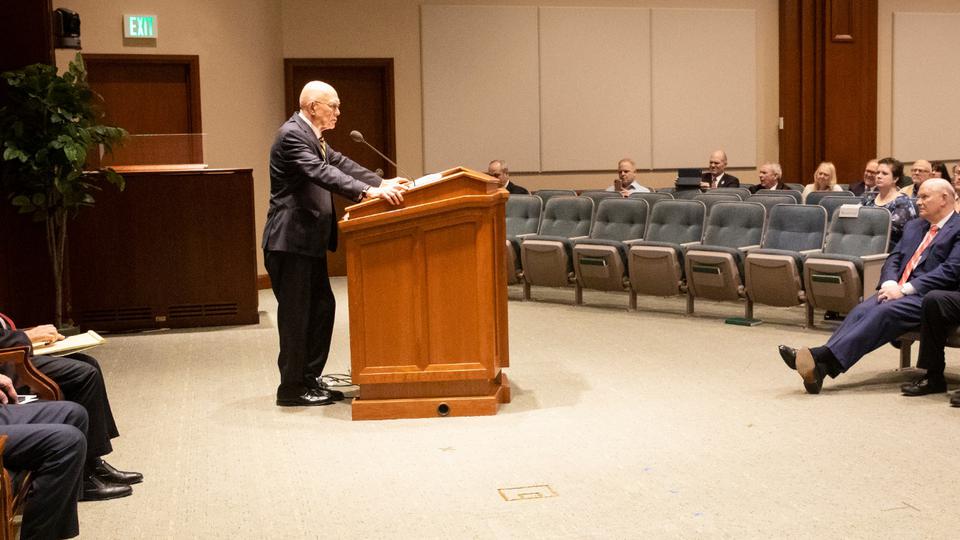
The CES Letter is a document written by Jeremy Runnells that lists “many serious problematic challenges to [the] foundational truth claims” of The Church of Jesus Christ of Latter-day Saints (LDS Church). Originally crafted in 2013 as a letter to a family friend employed by the Church Educational System (CES), it has since gained significant attention. It was posted online, where it quickly spread across various platforms, including Reddit. It has been read by thousands, if not millions, and has sparked intense debate among members and former members of the LDS Church.
Over time, the CES Letter‘s purpose evolved from a private communication into a public document aimed at encouraging individuals to question the Church’s truth claims. It argues that the Church is deceptive and inconsistent, that its history is filled with contradictions, and that continued belief in its teachings is unreasonable. Runnells claims that the LDS Church’s foundational truth claims are not only flawed but impossible to reconcile with historical facts.
The Content of the CES Letter
The CES Letter is a compilation of criticisms against the LDS Church. It brings up several well-known issues, such as the multiple accounts of the First Vision, the Kinderhook Plates, Joseph Smith’s polygamy, the Book of Abraham translation, and others. The document mixes facts, interpretations, and alleged misrepresentations, but its central premise is that the Church has been deceptive and, as a result, is not true.
One of the most significant issues the CES Letter raises is the First Vision accounts. Runnells argues that the LDS Church has perpetuated a misleading narrative about Joseph Smith’s First Vision, pointing out the discrepancies between the various accounts Joseph Smith gave over the years. Critics claim that these differences indicate dishonesty or error in Smith’s retelling of the event. On the other hand, defenders of the Church argue that the differences are relatively minor and can be explained by the context of each retelling.
Another major concern in the CES Letter is the Kinderhook Plates. These were purported ancient artifacts discovered in Illinois in 1843, which some critics claim were used by Joseph Smith to demonstrate his prophetic powers. However, the plates were later admitted to be a hoax. Critics use this incident to argue that Smith’s claims of translating ancient records were based on deception.
Joseph Smith’s practice of polygamy is also heavily scrutinized in the CES Letter. Runnells emphasizes the contradictions between Smith’s teachings on marriage and his actions, including marrying young women and women who were already married to other men. While this is a well-documented part of LDS history, defenders of Smith and the Church argue that his practice of polygamy was divinely sanctioned, even if it was not well understood by the general membership at the time.
The Book of Abraham translation is another point of contention. The CES Letter asserts that Joseph Smith’s translation of the Book of Abraham is problematic, particularly because the papyri he used for the translation have been shown to be common Egyptian funerary texts, rather than the ancient writings of Abraham. Supporters of the LDS Church claim that the Book of Abraham’s translation was not based solely on the physical papyri but that Smith was inspired to translate it in a way that does not necessarily require a literal translation.
The Debate Over the CES Letter’s Claims
While the CES Letter has garnered significant attention, the Church has not responded directly to its contents. However, several individuals, scholars, and organizations within the LDS community have offered detailed responses to the document. These responses range from point-by-point refutations to broader discussions about faith, historical context, and the role of personal testimony.
Critics of the CES Letter argue that it selectively presents facts and distorts evidence to fit its narrative. They contend that the document relies heavily on misunderstandings of Church doctrine and historical context. For example, the varying accounts of the First Vision can be seen not as contradictions, but as different perspectives on the same event. Defenders of the faith argue that Church leaders and scholars have explained these issues in depth, and that the CES Letter’s portrayal is incomplete or misleading.
On the other hand, some former members of the LDS Church who have read the CES Letter claim that it helped them better understand the issues they had with the Church. For them, the document serves as a clear and coherent explanation of the problems they had been grappling with in their own faith journey. The CES Letter’s impact is not limited to critics; it has also prompted many to reconsider their beliefs and examine their testimonies more deeply.
Mormonism Explained: Addressing the CES Letter
Mormonism Explained offers a broader context for understanding the LDS Church and the questions surrounding it. When trying to answer what is the CES Letter Mormon, it is essential to understand that the CES Letter tackles some of the core teachings and practices of the Church. It calls into question the truthfulness of the foundational stories and doctrines of Mormonism, and its influence continues to be felt in the faith communities and beyond. In order to understand the CES Letter debunking, it’s important to look at how different groups have engaged with its claims and whether they offer convincing refutations.
Many responses to the CES Letter focus on historical context and interpretations. Critics often argue that the criticisms in the CES Letter misunderstand the nuances of Mormon history. They also point out that much of the evidence cited can be interpreted in different ways. As a result, the CES Letter debunking becomes a discussion about how history, doctrine, and personal belief intersect.
Evaluating the CES Letter Summary and Its Impact
As we explore the CES Letter summary, it becomes clear that it is not just a list of criticisms but a broader attempt to challenge the Church’s claims. The CES Letter summary includes points that have been discussed widely in Mormon circles, such as Joseph Smith’s role as a prophet and the theological implications of the issues raised. For those interested in Mormon CES Letter summary or summary CES Letter, it’s crucial to examine the depth and breadth of the arguments presented.
While some readers may find the points in the CES Letter compelling, others believe that the document fails to address the complex and nuanced nature of faith. Many people’s experiences with Mormonism are deeply personal, and answers to these tough questions are not always simple. As some members of the Church have noted, what is the CES letter Mormon for one individual may not be the same as for another, as people wrestle with different aspects of the faith.
When Was the CES Letter Written?
When was the CES Letter written? The answer is in 2013, but its relevance continues to this day. The document’s timing, written during a period of growing scrutiny on the LDS Church, helped it gain traction and visibility. Since its release, the CES Letter has continued to fuel debates, both within and outside the Church. Its criticisms remain central to conversations about Mormonism and faith.
For those considering cesletter, it is essential to understand both the letter’s contents and the ongoing conversation surrounding its claims. Many find that reading the CES Letters critically leads to new insights and perspectives on both the Church’s history and its teachings. However, the document remains controversial, and each person’s response to it will be shaped by their own experiences and beliefs.
The Emotional and Spiritual Journey
Reading the CES Letter can be a profoundly emotional experience. For members of the LDS Church, encountering challenges to their beliefs can feel overwhelming. Questions about historical issues, doctrinal inconsistencies, and personal conflicts can provoke feelings of confusion, anger, and fear. This emotional response is something that Runnells and other critics of the Church often fail to address directly. While the CES Letter is filled with intellectual arguments, it does not always engage with the emotional and spiritual aspects of the faith.
For many members, faith in the LDS Church is not solely based on historical evidence or doctrinal certainty. It is deeply personal and spiritual. The experiences of the Holy Spirit, personal revelation, and a testimony of Jesus Christ often guide individuals through difficult questions. As the CES Letter challenges the truth claims of the Church, it does not account for the deep, personal experiences that many members have had.
Addressing the CES Letter: A Balanced Approach
When addressing the CES Letter, it’s important to take a balanced and thoughtful approach. One critical tip for individuals confronting the information in the CES Letter is to stay calm and avoid reacting impulsively. Many people find that taking a step back, considering the evidence carefully, and praying for guidance helps them process the information more effectively. The Church encourages its members to seek personal revelation and to rely on the Spirit to guide them through challenging questions.
It’s also vital to evaluate sources carefully. Just because something is presented as fact doesn’t make it true. The CES Letter includes many references to historical documents, but not all of these references are necessarily interpreted correctly. On the other hand, defenders of the Church point to other sources and explanations that offer alternative interpretations.
One of the key aspects of addressing the CES Letter is remembering that faith is a journey. No one’s testimony is built overnight. It is normal to wrestle with difficult questions and doubts. It is also important to remember that the Church teaches that the answers to our questions will come over time, through study, prayer, and personal revelation.
Conclusion: Finding Peace Amidst Doubt
The CES Letter is a powerful document that has prompted many individuals to question their faith and examine the truth claims of The Church of Jesus Christ of Latter-day Saints. While it offers a critical perspective, it also serves as an invitation to engage with difficult questions and wrestle with doubts in a constructive way. The journey of faith is not without challenges, but for many, it is in confronting these challenges that their testimonies are strengthened.
For members of the Church, the CES Letter should not be the final word on their faith. Rather, it can be a tool for deeper exploration and greater understanding. As individuals seek answers to the questions raised by the CES Letter, they should remember that their spiritual journey is uniquely their own, and that peace and clarity will come through sincere inquiry, personal revelation, and faith.
In the end, the CES Letter is just one voice in a much larger conversation about faith, history, and truth. Whether one agrees with its conclusions or not, it is important to approach it with an open mind and a heart willing to search for answers. And through it all, the guiding hand of the Spirit can lead the way, offering comfort and peace as individuals navigate their own path.

By Todd Noall, Source Expert
Todd Noall is an author and religious scholar at Mormonism Explained with a focus on the history and theology of religion.

Fact Checked by Mr. Kevin Prince, Source Expert
Kevin Prince is a religious scholar and host of the Gospel Learning Youtube channel. His channel has garnered over 41,000 subscribers and accumulated over 4.5 million views. Mr. Prince also created the Gospel Learning App, a reliable platform where individuals seeking truth can access trustworthy answers to religious questions from top educators worldwide.
About Mormonism Explained
Mormonism Explained is a resource that was designed to provide objective and factual information about Mormonism, its history, doctrines, and policies. Our team of researchers consults experts and primary sources to present factual information on a variety of topics relevant to the Mormon Church.
Tags
